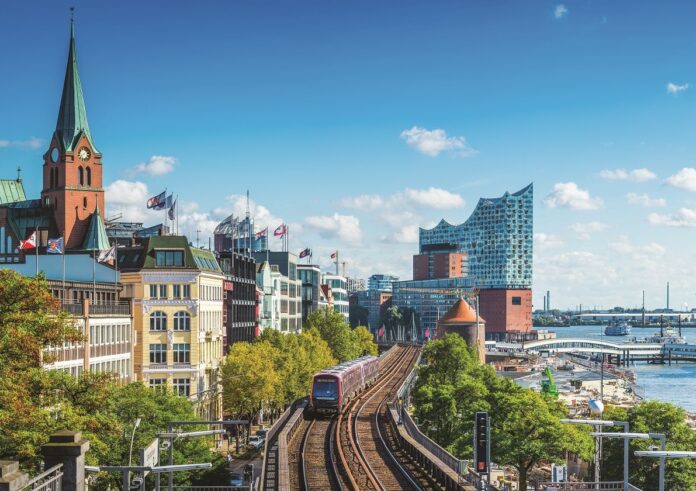Christopher Herzog, Arnd Wendland and Claudia Wendland share the experiences of Hamburg Wasser – the second largest German water and wastewater utility – in its response, up to August 2020, to the COVID-19 pandemic.
Hamburg Wasser is a group of publicly owned water and wastewater utilities serving more than two million consumers in the metropolitan region of Hamburg, Germany.
Prior to the COVID-19 pandemic, Hamburg Wasser had created a variety of emergency and crisis management protocols, including responses to coliform bacterial infections in the network, storm tides, and terrorist threats. An emergency plan has also existed for pandemic situations.
Capacity building of crisis management team members is a central instrument of our strategy, with regular training and testing of structures and procedures. At the end of 2019, Hamburg Wasser conducted just such a joint team exercise, in cooperation with the electricity and gas network operators in Hamburg.
Emergency management during COVID-19
Shortly before the first coronavirus case in Hamburg was identified, it was decided to set up a cross-divisional emergency committee. Hamburg Wasser considered the pandemic as an ‘emergency’ for the company rather than a ‘crisis’. However, the crisis management tools were applied. As a result of the pandemic scenario, all meetings of the committee were conducted exclusively via telephone and video conference.
The first meetings were a test run in terms of digital communication, as well as a first attempt to grasp the extent of the work ahead. The preparations of the past few years proved to have paid off and were updated and revised continuously. Responsibilities and communication structures were defined and working methods were coordinated.
Including vacation replacements, 23 people were part of the emergency committee, from different departments. The focus of the committee was to centralise the collection of information, assess the situation, identify critical developments, and prepare responses, all under the motto of ‘staying ahead of the development’.
The head of operation has the authority for final decisions in the emergency committee and keeps in close contact with the two CEOs and the staff councils.
Collaboration
Contacts with other water suppliers and network operators were established at various levels. Best practice information was exchanged with bilateral and informal contacts. A regular exchange took place with the company doctors of two other public operators. We also rely on the assessments and recommendations of the German Robert Koch Institute and the Federal Ministry of Health.
Ensuring access to services
It quickly became clear that the pandemic would not be over in a few weeks and that the situation would continue to worsen. Accordingly, the aim was to maintain ‘normal operation mode’ as much as possible, while observing special hygiene rules.
The following strategic action lines were developed by the emergency committee:
- Delaying the spread of the virus and minimising concurrent diseases to keep the number of people who fall ill at the same time as low as possible
- Protection and support of particularly affected employees
- Preparation of an emergency operation for a worsening of the situation.
Concrete measures to operationalise these were developed by the committee. The focus of the measures was to limit contacts for all employees, and to allow only contacts necessary for operations under special hygiene rules. Office employees worked from home where possible (1300 employees, out of 2400, could do so). Others, whose roles did not allow them to work remotely, or who are technically unable to do so, continued to work on site with specific hygiene rules and in strictly separated teams. The IT services for networks, hardware and software were improved and upgraded very quickly so that staff could work adequately from home. Overall, the company reduced onsite presence of staff from approximately 75% to 20%.
Consumer-related measures
The Federal Ministry of Justice put civil legislation in place authorising deferments on water bills. All customers – households, as well as industrial – were informed of this. To date, very few private or industrial customers have requested it. In addition, it was decided to suspend all water cut-offs. Changing water meters in households was also suspended and the customer service centre was closed to physical visits.
Analysis of critical process components and emergency plans
The highest risk in the pandemic has been the possibility that a process breaks down because of the lack of staff present on site. To be prepared, a systematic approach was developed to identify staff shortages in critical processes. The methodology is based on a German norm (DIN-EN 15975-2) and was further adjusted to adapt to emerging circumstances.
This analysis was carried out according to the following three steps:
- All critical water supply and wastewater disposal process modules were identified
- All key staff functions were identified
- Process modules and key functions were evaluated in terms of their criticality using a traffic light system. A systematic evaluation matrix was developed for the assessment of personnel availability.
In the end, 59 process modules and 128 key functions were identified in a risk matrix. The results reflected the overlap of particularly critical processes with particularly critical key functions. To reduce these risks, special protective measures had to be defined and implemented.
Measures to reduce the vulnerability of specific process components were carried out in addition to the measures mentioned above, such as physical and temporary segregations.
Recovery and returning to the ‘new normal’
Although infection figures in Hamburg decreased significantly between April and May 2020, the virus continued to circulate and the situation in Hamburg worsened again. For the emergency committee, therefore, it became necessary to develop options for coping with a ‘new normal’.
Hamburg Wasser opted for a three-stage process to limit potential chains of infection and gradually increase onsite presence. The process depends on a drop in new infections in Hamburg and surrounding federal states. If these are stable at a low level (e.g. < 25 per week per 100,000 inhabitants), relaxation of restrictions is conceivable. However, infection numbers at Hamburg Wasser itself are also relevant, and the number – as well as the potential chains of infections and quarantine effects – must be taken into account. To be able to evaluate the effects of relaxation restrictions on infection rates, intervals between the stages should be at least four weeks.
Lessons learned
In summary, the measures taken have been successful so far. Hamburg Wasser has not entered a crisis. Only a few employees of Hamburg Wasser have been infected by the virus. Internally, there was widespread solidarity and understanding of the situation among the staff. In particular, the transparent communication and sharing of information were much appreciated by employees.
Although the crisis has not yet ended, some of the key lessons learned so far are:
Identifying key challenges: reorganisation of the daily work and communication were the two central tasks.
Emergency management: even though there was no crisis from the perspective of water supply and wastewater disposal, we made use of crisis management structures. The experience gained through regular crisis management exercises since 2015 has been an important success factor.
Decision making: even though the head of the emergency committee formally had the authority to make decisions, final decisions were always based on the collective discussion and consensus.
Long-term crisis: during the first phase of the pandemic, it was not clear that the changes made would be in place for a long time. Initially, actions were only a reaction to the current situation. Only gradually were more long-term perspectives developed and strategies derived from them.
Preparing for a pandemic: although a pandemic was considered an unlikely scenario, basic principles for dealing with such a crisis were in place in the emergency plan, which proved to be very helpful and gave useful guidance. More detailed solutions were developed as the crisis unfolded.
Stockpiling of consumables: there were considerable supply bottlenecks, especially for protective clothing and hygiene articles. This must be considered as part of emergency planning in the future.
Technical requirements: independent from the pandemic, it was fortunate that about 80% of our employees had been equipped with laptops a few months before. This enabled mobile working very easily and can now be used as an important basic requirement for working from home.
Cooperation: regular networking within the sector and with other public companies has proved useful, and should be further encouraged, allowing for a faster exchange of ideas in the event of another crisis.
Conclusion
The findings from the emergency response at Hamburg Wasser are still at a very early stage, but two outcomes are quite clear as we look forward to longer-term planning.
The first is that our positive experiences with updated IT indicate there will probably be more working from home in the future. If work processes and team cohesion allow, this could be up to 60% of working time.
Second, our work will probably be more digitalised. Certainly, more meetings will be held via video and telephone. In terms of operation and maintenance, there was already a high level of digitalisation, so there will probably be no fundamental change in the technical installations. When working in the field, however, it will be more common to start directly from home.
Hamburg Wasser is confident that, for many employees, the daily routine will change after the COVID-19 pandemic. •
The authors
Christopher Herzog is Engineer and Crisis Management Expert, Network Department
Arnd Wendland is Head of Central Waterworks
Claudia Wendland is Senior Water and Sanitation Expert, Urban Infrastructure Coordination and Hydrology Department
All at Hamburg Wasser
Acknowledgement
This article is a shortened version of a case study made available through the efforts of the International Water Association’s COVID-19 Task Force as a contribution on ‘lessons learned’ during the pandemic.
The Task Force thanks the authors for sharing their experience. See the full case study, with figures, at iwa-network.org/news/information-resources-on-water-and-covid-19
For more information on the Task Force, see: iwa-network.org/groups/covid-19-task-force








